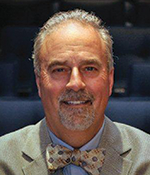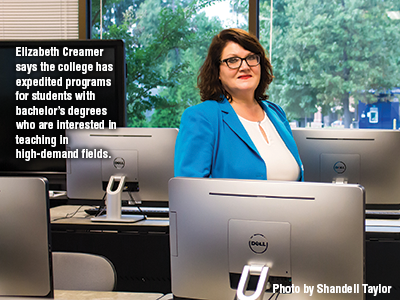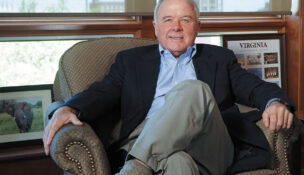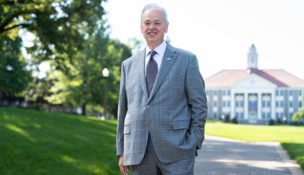The enrollment roller-coaster
Numbers fall in a rising economy, but college continues to train students to meet workforce needs
Gary Robertson //October 27, 2017//
The enrollment roller-coaster
Numbers fall in a rising economy, but college continues to train students to meet workforce needs
Gary Robertson //October 27, 2017//
At the opening convocation of J. Sargeant Reynolds Community College in late September, President Gary Rhodes listened to the school’s alma mater, introduced and recognized other guests and college board members gathered on the college’s Henrico County campus.
Rhodes noted that the college foundation had, among other moves, awarded $500,000 in student scholarships while raising money for a new IV pump for the health-care programs, a 3-D printer for engineering and a drone for horticulture studies. He also went over some improvements at the college’s three campuses in Henrico, Goochland counties and Richmond.
Then, under a PowerPoint slide headlined “Challenges,” Rhodes dropped a bombshell. “Enrollments are down 25 percent over the past five years,” he said. The audience greeted the revelations with silence.

In 2012, when Virginia’s economy still was clawing its way out of the Great Recession, Reynolds hit an enrollment high of more than 20,000 students. Many sought workplace skills to help them find new jobs or careers.
Now, with Richmond’s unemployment hovering at 4 percent or less, enrollment has dipped to 16,800 or so. People are less likely to enroll in college when they have jobs and things are good, Rhodes notes.
He says the formula for the roller coaster that community colleges ride in enrollments is simple. “Weak economy equals strong enrollments. Strong economy equals weak enrollments,” he explains.
Every year, Rhodes says, the college makes “a conservative guesstimate” of what its enrollment will be. If enrollment falls, and the cash flow from tuitions is lower than expected, faculty and staff are not replaced if they leave or various programs are merged.
“Ultimately, we want to have healthy enrollment, and it’s not just the money side. It’s the workers,” Rhodes says. “Pick any industry out there, and they’re just screaming that they can’t find trained workers.”
Students from 42 countries
Preparing those workers is a top priority for Reynolds and other community colleges. Students obtain industry certification, earn associate degrees or transfer to four-year institutions for more education. On average, about 900 students transfer each year from Reynolds.
Rhodes, a former board chair of the Greater Richmond Chamber of Commerce (now, ChamberRVA), says his favorite data point — one that nearly always gets an audience’s attention — is this: “One out of every four workers in the Greater Richmond region has attended Reynolds Community College, and one in every three health-care workers,” Rhodes says, citing a study by the Richmond-based SIR consulting firm.
Since Reynolds opened in 1972, it has become the third-largest community college in Virginia (behind Northern Virginia and Tidewater community colleges), and officials say that more than 310,000 students have enrolled in for-credit courses.
Today, half of Reynolds students are taking one or more classes online, and 17 percent are earning all of their credits online. This fall, the student body included representatives from 42 foreign countries, including war-torn Afghanistan.
Besides fluctuations in the economy, Rhodes cites other factors that affect enrollment.
Low birth rates 18 years ago led to fewer U.S. students entering college in 2017. Also, state funding has dwindled over the years from 60 percent to 35 percent of Reynolds’ operational budgets, Rhodes says. As a result, tuitions are higher, and students have to shoulder more of the costs.
To boost its student body, Reynolds is making the enrollment process simpler and engaging more students while they are still in high school or middle school, through programs such as Advance College Academies. Under that program, outstanding high school students can earn associate degrees while completing their high-school diploma requirements.
The program has set up an interesting dynamic for its high school seniors. They are awarded their associate degrees in May before they receive their high-school diplomas in June. “They graduate from college before they graduate from high school,” Rhodes says with a laugh. In 2017, 63 high school students graduated from the program.
Students typically apply to an academy program in the eighth grade through their local school division, enroll in advanced high-school courses in the ninth and 10th grades and take the required college coursework for their associate degrees during the 11th and 12th grades. “They will stay together all four years,” Rhodes says of students in the program.
JLARC report
Community colleges are likely to come under scrutiny at the next session of the General Assembly as the result of a report issued in September by the state Joint Legislative Audit and Review Commission (JLARC).
Among other findings, JLARC reported that only 39 percent of Virginia’s community college students earned degrees or other credentials, a trend in line with patterns seen across the nation.
JLARC also says that the process and resources enabling community college students to transfer to four-year institutions are difficult to use.
JLARC adds that rising tuition rates and fees at community colleges could affect access, affordability and student success. During the past 10 years, tuition and fees have grown from 6 percent of per-capita disposable income to 11 percent, the report says.
Echoing comments by community college Chancellor Glenn DuBois, Rhodes notes that, while there is room for improvement, many of the issues raised by JLARC can be traced to the different populations served by community colleges and four-year institutions. Generally speaking, community college students are older, poorer and attend college part time, Rhodes says. “Seventy-five percent of our students are part time,” the Reynolds president says, “and 75 percent work.”
Workforce development

“The Community College Workforce Alliance, which is a partnership of Reynolds and John Tyler [Community College], was No. 1 in the state for workforce credential attainment, No. 1 for the number of people we have enrolled in the program,” says Elizabeth Creamer, vice president for workforce development at Reynolds.
As of mid-September, more than 900 students have been through the program under the Reynolds/Tyler alliance. The principal driver of the program has been the Workforce Credential Grant, established by the legislature, which has just completed its first year.
Under the grant, the state pays two-thirds of the tuition costs directly to the college, with students responsible for the other third. But requirements are stringent. The college is paid a third of the cost only when a student successfully completes the course, and the final third is received only if the student successfully obtains a credential or certification from an industry or certifying agency.
The bar also is high even before the first dollar is paid. “You can only get a credential through the state at greatly reduced or no cost if it’s aligned with a regionally available job for which there is a documented shortage of workers,” Creamer says.
Besides preparing students for high-demand occupations, the program also certifies teachers.
Those teachers, who must already possess a bachelor’s degree before they enter the program, are largely destined for public schools in subject areas where instructors are hard to find: technical education, science and technology, engineering technology and mathematics.
“We’re not going to get the teachers in the fields we need through the teacher education programs at the universities,” Creamer says. “So, we have expedited programs for those who have a baccalaureate and who are willing and able to go into teaching. They can access that job now and get their teaching credentials in a matter of months, not years.”
Transfer students
Reynolds also transfers about 900 students annually to four-year institutions. One of them was Sofia Duarte, whose parents operate a small residential cleaning service in the Richmond area.
Duarte, now 21, says she chose to go to a community college to save on higher-education costs — about $20,000 less when a student first goes to a community college and then transfers — and to help ensure that her parents had enough money to help her younger sister.
Duarte, an honors student, earned scholarships at Reynolds, worked a variety of part-time jobs, and then transferred to Virginia Commonwealth University where she is now a senior in the School of Engineering, earning a degree in electrical engineering. “Honestly, for me Reynolds opened a lot of doors to meet amazing people and have amazing opportunities,” Duarte says. She says Reynolds offered small classes, good teachers and strong academic advising.
And her younger sister, Sabrina, 18, whom she mentored, has done okay, too. She’s now enrolled at the University of Richmond, on scholarship.
Rhodes, who is now in his 16th year as president of Reynolds, says he knows enrollments will continue to fluctuate as the economy fluctuates. But that’s not what concerns him most.
He is worried about many young people and adults — from underemployed baccalaureate degree holders who can’t find jobs in their field to high school dropouts to laid-off workers — who could benefit from the wide variety of programs offered by Reynolds. “Everything we do here at the community college is preparing people for life and careers,” Rhodes says.
>
















